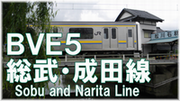|
Signal
Departure signal/Entering signal/Block signal
It is called a main signal, and each traffic light has a section securing the safety of the train.
It also shows the permission to enter and leave the station and the way it goes in the turnout.
|
|
Proceed
"Shinko"
|
Slow down
"Gensoku"
|
Caution
"chuui"
|
Speed restriction
"Keikai"
|
Stop
"Teishi"
|
|
|

|

|

|

|

|
| Chiba to Narita
|
No limit of signal.
|
75 km/h or less
|
55 km/h or less
|
25 km/h or less
|
Stop
|
| Narita to Sawara, Kahima-Jingu
|
65 km/h or less
|
45 km/h or less
|
25 km/h or less
|
| Locomotive
|
65 km/h or less
|
45 km/h or less
|
25 km/h or less
|
Relay signal
Relay signal is installed for the purpose of relaying the indication of the main signal and supplementing the confirmation distance when the distance at which the main signal (Departure signal/Entering signal/Block signal) can be confirmed is influenced by the influence of a curve.
|
|
Relay proceed
"Chukei-Shinko"
|
Relay limit
"Chukei-Seigen"
|
Relay stop
"Chukei-Teishi"
|
|
|

|

|

|
| Next main signal
|
Proceed signal
|
Slow-down or Caution or Speed-restriction
|
Stop signal
|
Shunting signal
It is a signal for a train to shunting at the station.
|
|
Proceed
"Shinko"
|
Stop
"Teishi"
|
|
|

|

|
| Meaning of Signal indicate.
|
Proceed
(45km/h or less)
|
Stop
|
Hazard warning indicator
It is a indicator used when you need to stop the train in an emergency.
If you confirm the flickering of the signal you must immediately stop the train.
|
|
Normal
|
Emergency
|
|
|

|

|
| Meaning of indicate.
|
It is a normal state.
|
Emergency situations such as railroad crossing trouble and falling rock detection are occurring on the tracks ahead.
Immediately please stop the train.
|
Indication
Speed limit indicator
The speed limit indicator is installed in the section where it is necessary to reduce the speed from the maximum speed of the route because of the curve, turnout, rail condition etc.
|
|
Speed limit indicator
|
Speed limit indicator
with limit distance
|
Speed limit indicator
for turnout
|
Speed limit indicator
2 starge
|
|
|
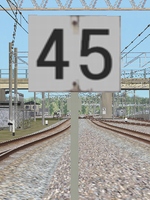
|
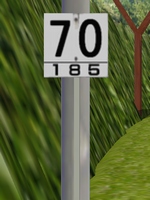
|
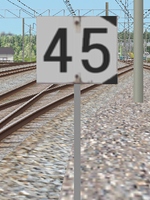
|
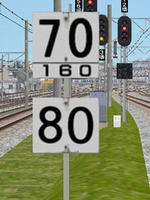
|
| Explanation of indication
|
Numbers indicate speed limit.
(Unit:km/h)
|
Numbers indicate speed limit.
The lower number is the limit distance.
|
Numbers indicate speed limit for turnout
Speed limit of Train turning in the direction of the black triangle.
The limit is canceled when the trailing end of the train exceeds the turnout.
|
Numbers indicate speed limit.
The number shown in the lower row is the speed limit for express trains.
|
| Locomotive
|
Indicate Numbers
|
Indicate Numbers
|
Indicate Numbers
|
Indicate Numbers of up side
|
| Series 113/115 EMU
|
Indicate Numbers
|
Indicate Numbers
|
Indicate Numbers
|
Indicate Numbers at of side
|
| Series 209/211/E217 EMU
|
Indicate Numbers
|
Indicate Numbers
|
Indicate Numbers
|
Indicate Numbers of up side
|
| Express train
|
Indicate Numbers
|
Indicate Numbers
|
Indicate Numbers
|
Indicate Numbers of lower side
|
|
|
Speed limit indicator
2 starge(Green marker)
|
Speed limit indicator
2 starge(Orange marker)
|
Speed limit indicator
for local train
|
Limit end indicator
|
|
|
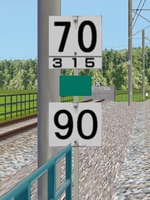
|
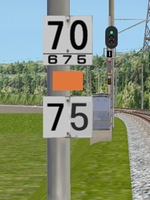
|
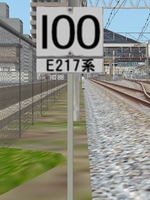
|
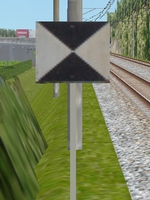
|
| Explanation of indication
|
Numbers indicate speed limit.
The number shown in the lower row is the speed limit for express trains.
If there is a green marker, the speed limit will be higher than the display of the Local train.
|
Numbers indicate speed limit.
The number shown in the lower row is the speed limit for express trains.
If there is a orange marker, the speed limit will be higher than the display of the Local train.
|
Limited speed for local trains with maximum speed exceeding 100 km/h.
There is no speed limit for express trains.
|
It is installed at the position where the speed limit ends.
The limit will be lifted when all the vehicles pass this position.
|
| Locomotive
|
Indicate Numbers of up side
|
Indicate Numbers of up side
|
No limit
|
Limit end
|
| Series 113/115 EMU
|
Indicate Numbers of up side +5km/h
|
Indicate Numbers of up side +5km/h
|
Indicate Numbers
|
Limit end
|
| Series 209/211/e217 EMU |
Indicate Numbers of up side +10km/h
|
Indicate Numbers of up side +5km/h
|
Indicate Numbers
|
Limit end
|
| Express train
|
Indicate Numbers of lower side
|
Indicate Numbers of lower side
|
No limit
|
Limit End
|
Other indicater
It shows information on routes and positions, and instructions on driving.
|
|
Route indicater
|
Horn ringing
|
Acceleration start
|
Acceleration End
|
Signal Call
|
|
|

|

|

|

|

|
| Explanation of indication
|
It is attached as an auxiliary indication that shows the previous course when signal are shared by two or more directions.
It shows that it is on the right side in the above figure.
|
It is installed in places where it is necessary to sound a horn to inform of the approach of the train.
|
Estimated to start acceleration
|
Estimated to end acceleration
|
Indicates that the station is approaching.
|
|
|
Station approach
|
Boundary of substation segment
|
ATS change
|
|
|

|

|

|
| Explanation of indication
|
Indicates that the station is approaching.。
|
Substation which supplies power to overhead wire will change with this display as the boundary.
Because there is a possibility that the electric wire will cut due to the potential difference, you must not stop the train across this sign.
|
ATS changes from P type to S type from the position of the indicater.
|
|
